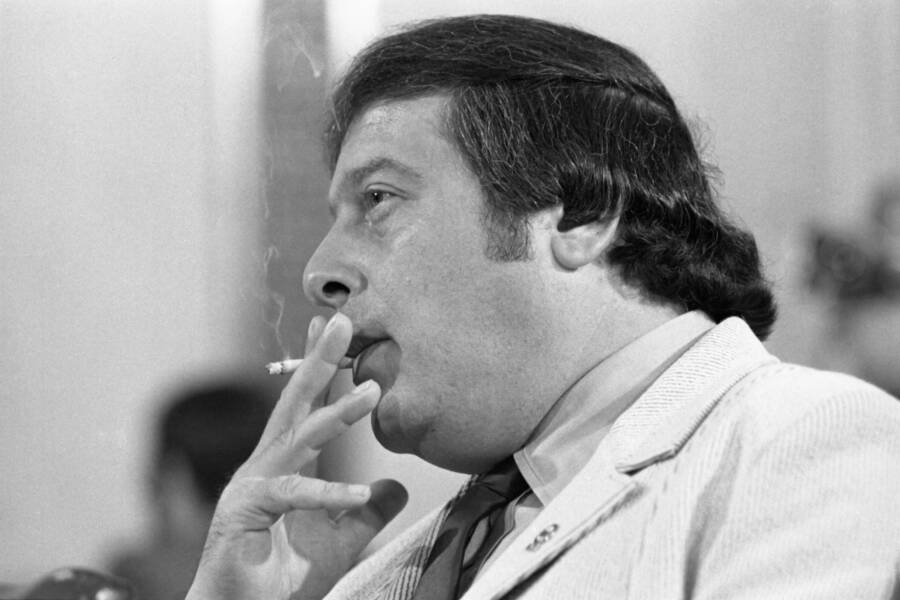Colombo family capo Greg Scarpa was so ruthless and deadly that he became known as the "Grim Reaper" — but he also spent 30 years secretly working as an FBI informant.

Bettman/Getty ImagesKnown as the “Grim Reaper,” Colombo family capo Greg Scarpa was one of the most feared men in the Mafia for decades.
Some called him the “Grim Reaper.” Others referred to him as the “Mad Hatter.” In either case, his name was likely to send shivers down the spine — because Greg Scarpa was every bit as fearsome as his nicknames implied.
A Colombo crime family caporegime and hitman, Scarpa was a career criminal involved in countless illegal gambling, loansharking, extortion, and hijacking operations. He also dabbled in assault, theft, narcotics trading, and, of course, murder. His crew was among the best of the best, and Scarpa himself soared through the ranks of the Mafia.
But in 1962, his world came crashing down when he was arrested for armed robbery. To avoid prosecution, Scarpa struck a deal with the FBI, marking the beginning of a 30-year-long partnership with the bureau — one that came in handy for the FBI, as they would later recruit Scarpa to help intimidate the Ku Klux Klan after the “Mississippi Burning” murders.

NYPDIn the 1950s, Greg Scarpa became involved with the Colombo crime family and quickly rose through the ranks. Soon, he was a chief enforcer and one of the most feared hitmen in the Mafia.
And while working with the FBI, Greg Scarpa remained just as ruthless a mobster as ever. In fact, he reportedly bragged that he stopped counting the number of people he’d killed after he hit 50. This is his story.
Greg Scarpa’s Rise Through The Ranks Of The Mafia
Gregory Scarpa was born to Italian immigrants on May 8, 1928, and raised in the Bensonhurst neighborhood of Brooklyn. As a young child, he worked with his father to deliver coal to help his family scrape by during the Great Depression. Then, sometime in the 1950s, he was introduced to the Colombo crime family.
Within the Colombo family, Scarpa quickly established himself as a force to be reckoned with. He became known as the “Grim Reaper” because of the sheer number of murders he carried out (he reportedly stopped counting at 50). As Linda Schiro, Scarpa’s girlfriend of 30 years with whom he had two children, told the New York Post in 2007, “If it was a big murder, an important one, he would leave the numbers 666 on some of the guys’ pagers.”
Greg Scarpa was involved in all aspects of the crew. He ran gambling, loansharking, and extortion operations, regularly carrying about $5,000 in cash on his person to hand out bribes to people. Meanwhile, he was a prolific Mafia hitman in his own right. And he was good at what he did. Behind the scenes, however, he lived a sort of double life: no-nonsense mobster by day; loving father by night.
“There was no one tougher than Greg,” Schiro said. “Yet there was an outside to him and an inside to him. Inside, strangely enough, he was truly sensitive… Greg was a murderer, but we were so much in love.”

Scarpa FamilyGreg Scarpa with Linda Schiro, his daughter who was named after her mother.
Greg Scarpa earned himself enough money working for the mob that he could live in a lavish Manhattan apartment while owning homes in Brooklyn, Staten Island, Las Vegas, and Singer Island, Florida. He became a caporegime and the proprietor of the popular Mafia hangout spot known as the Wimpy Boys Social Club.
“Greg was a true Machiavelli,” his former attorney, Louis Diamond, told the New Yorker in 1996. “He was the puppeteer. He lived to manipulate people against people.” According to Diamond, Scarpa was “one of the better gin-rummy players,” which showed off his “brilliance” and “ability to focus and plan.”
Then, in 1962, everything changed.
How An Armed Robbery Led The “Grim Reaper” To Work With The FBI
After Greg Scarpa participated in an armed robbery in 1962, FBI agents snatched him outside his home and brought him in for interrogation. Despite his known mob connections, Scarpa only ever spent a few months in total behind bars and reportedly “hated doing time,” according to one associate.
So, when the FBI offered him a deal that would keep him out of prison, he was quick to accept. It was a clever move on the part of the bureau, too — most mobsters believed that the FBI wouldn’t work with killers, and according to one associate, “[Scarpa] was crazy. He killed a lot. He was nuts.”

Public DomainGreg Scarpa was known as the “Grim Reaper” of the Mafia.
Greg Scarpa’s status as a killer thus provided the perfect disguise for him as a snitch. Even better, working with the FBI meant he would stay out of prison. Plus, he’d earn more money in informant fees from the agency.
Then, in 1964, just two years into his time as an informant, Scarpa played what is arguably his most important role for the FBI.
How Greg Scarpa Helped The FBI With The “Mississippi Burning” Murders
In 1964, the Ku Klux Klan, riding high on a string of murders, killed three civil rights activists in what would famously become known as the “Mississippi Burning” murders. The Klan buried their bodies in a dam near Philadelphia, Mississippi, sparking a nationwide manhunt.
The victims, James Chaney, Andrew Goodman, and Michael Schwerner, had traveled to Mississippi as part of the Freedom Summer campaign to help African Americans register to vote.
The FBI knew they had been murdered, but they couldn’t locate their bodies. J. Edgar Hoover was facing pressure from the media to find the men, but he had exhausted his manpower looking for them with nothing to show for it.

Public DomainThe bodies of the three victims in the “Mississippi Burning” murders.
Enter Greg Scarpa.
The FBI called their informant and secretly flew him down to Mississippi. According to a 2007 report in The Guardian, Linda Schiro claimed she and Scarpa checked into a hotel in Neshoba County, and Scarpa winked at one of the agents.
A few minutes later, the agent entered their hotel room and handed Scarpa a gun. Scarpa then changed his clothes and left money on the dresser, telling Schiro that if he didn’t come back, she should take a cab to the airport and go back to New York.
He did come back, however, not too long after he had left. Scarpa later told Schiro that he had kidnapped a local salesman and secret klansman, Lawrence Byrd, after catching him off guard by helping him carry a television to his car. He then put a gun in Byrd’s mouth and threatened him. Of course, the FBI has never confirmed this version of events.
In any case, the story goes that the klansman folded and told Scarpa where the bodies were. When Greg Scarpa returned to the hotel, he met with the agent and traded the gun in for a wad of cash. Then, he and Schiro returned to New York.
He reportedly helped the FBI on another KKK murder case in January 1966 that resulted in a disagreement over his payment and a split between Scarpa and the agency — at least until 1980. That year, he became an informant once again, this time working with handler Lindley DeVecchio.

Public DomainSurveillance footage of Greg Scarpa, the Colombo family capo known as the “Grim Reaper.”
Greg Scarpa, Lindley DeVecchio, And The Third Colombo War
Despite Greg Scarpa wanting to distance himself from the FBI, DeVecchio was determined to pull him back in. DeVecchio, however, wasn’t exactly a model agent. He was crooked, and he and Scarpa formed a fairly close relationship. He would frequently dine with Scarpa and his family at the mobster’s home, much to the chagrin of many of DeVecchio’s colleagues.
In fact, some would later suggest that DeVecchio was partly responsible for some of the murders Scarpa carried out throughout the 1980s and ’90s, particularly during the Third Colombo War. DeVecchio allegedly provided Scarpa with the names of rival mob associates — who would turn up dead shortly thereafter.
“Lin knew when he gave Greg a name of somebody what would happen,” Schiro said.

ZUMA Press, Inc. / Alamy Stock PhotoLindley DeVecchio, the federal agent who worked with Greg Scarpa.
When DeVecchio took the stand during the trial of Victor Orena, who was blamed for kicking off the Colombo wars, DeVecchio was reportedly “arrogant, hostile, and talked like a gangster himself,” Orena’s son Andrew said, according to the New York Post. “He was protecting Scarpa. He was useless.”
DeVecchio was ultimately cleared of any counts of murder levied against him during his own trial. Greg Scarpa, on the other hand, had landed himself in trouble with the law once again in 1985, landing a sentence of five years of probation with no prison time. This led to suspicion within the Colombo family that the mobster might be working with the FBI.
The Unexpected Death Of Gregory Scarpa
In 1986, Greg Scarpa underwent emergency ulcer surgery and received several blood donations from family members and associates — one of whom was Paul Mele, a bodybuilder who had contracted HIV from a dirty steroid needle and then passed it on to Scarpa.
Scarpa eventually filed a lawsuit and was awarded a $300,000 settlement in 1992, but the violence of mob life hadn’t abandoned him. While under house arrest that same year, Scarpa was involved in a shootout with Michael DeRosa and Ronald Moran in which he lost an eye.
Then, once again, Scarpa got into legal trouble. He pleaded guilty to three murders and conspiracy to murder in May 1993, and he was sentenced to life in prison in December of that year. However, just six months later, on June 4, 1994, Greg Scarpa died of AIDS-related complications at the Federal Medical Center in Minnesota.
The man who had taken so many lives finally met the Grim Reaper himself.
After learning about the life and crimes of Greg Scarpa, learn about the most powerful Mafia bosses of all time. Then, check out these images of the American Mafia in the 1980s.





